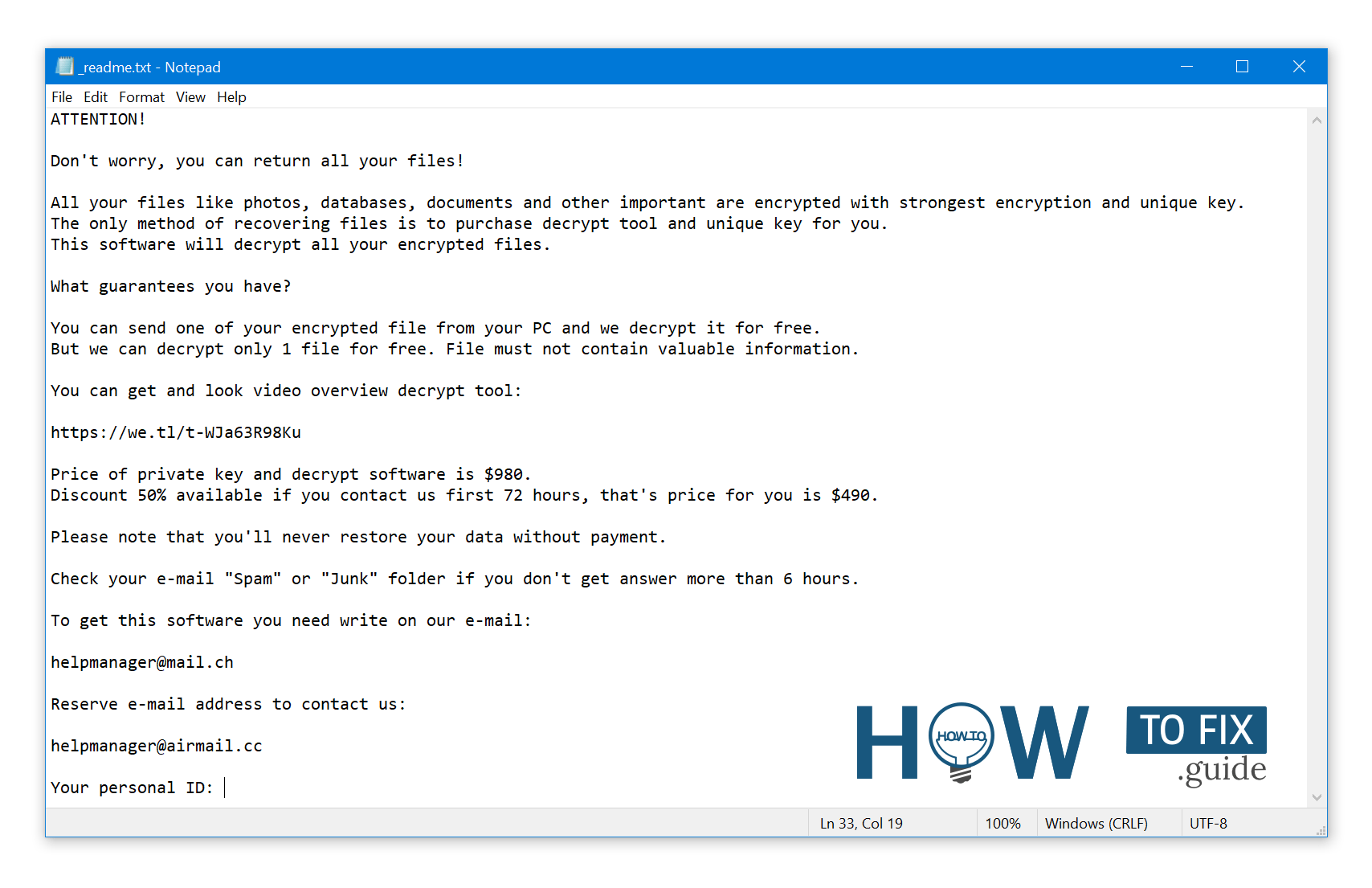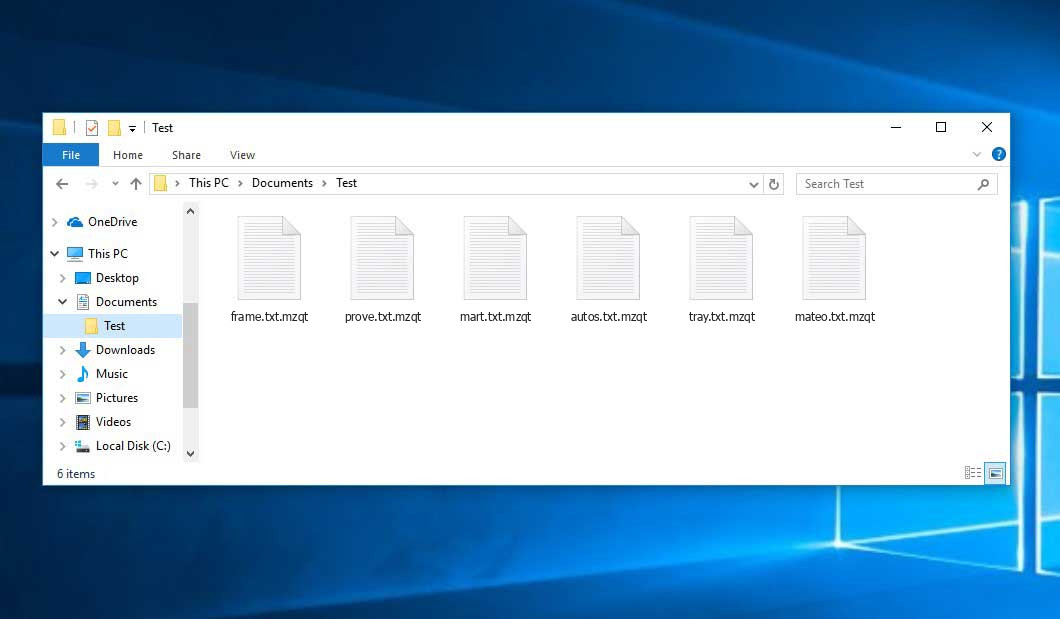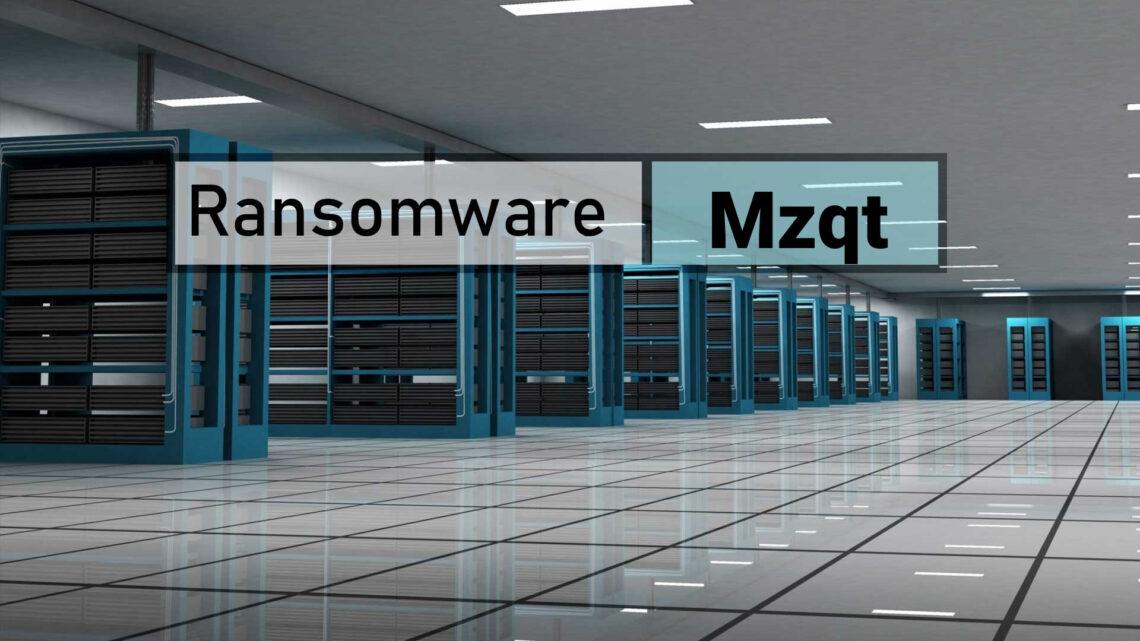The Mzqt virus is a ransomware infection, a part of the STOP family. The key action this malware performs is malignant file encryption. When the Mzqt virus gets into a computer, it targets various types of files, such as documents, videos, photos, and more. It modifies the file structure and appends the “.mzqt” extension to each file, making them unusable without the decryptor.
Mzqt Virus Overview
Mzqt
🤔 Mzqt malware can be classified as ransomware that belongs to the DJVU/STOP family. Its primary purpose is to lock all of your files it can reach. After that ransomware virus asks its victims for a ransom payment – ($490 – $980) in Bitcoin.
The Mzqt virus is a malicious program that ciphers your files and forces you to pay for their recovery. This malware encrypts different file types. You can distinct ciphered files by an “.mzqt” extension. These files are no longer accessible and usable due to the application of a cipher.
After that, the ransomware demands a ransom payment in Bitcoin from the victims, ranging from $490 to $980. Typically, it creates a text file with ransom payment guidances – “_readme.txt“.
The encryption algorithm in STOP/Djvu ransomware is AES-256. So, if your data got encrypted with an online decryption key, the chances to get your files back are quite low. Thing is, the key is unique for each victim, and picking it will take exceptionally big amount of time.
Mzqt uses a unique key for every victim, with one exception. When Mzqt fails to establish a connection with its command and control server (C&C Server) before starting the encryption process, it resorts to using offline keys. This key is the same for all users, which allows for further file decryption.
Retrieving the online decryption key in any way is merely impossible. It remains on a command server under the rule of crooks who spread the Mzqt malware. For receiving unlocking key the payment should be $980. Hackers offer to reach them on the email (support@fishmail.top) for payment and decryption instructions.
Once Mzqt malware finishes the encryption, it shows a ransom note to the victim, demanding a ransom payment in exchange for the decryption key. The ransom note provides instructions on how to make the payment and also often contains threats of system wipeout or ransom amounts surge if the demands are not met within a specified timeframe.
This message asking payment is for restore files via decryption key:

_readme.txt (STOP/DJVU Ransomware) – The frightening warning demanding users to pay off the ransom to decrypt the encrypted data contains these exasperating admonitions.
I have made an all-encompassing list of potential solutions, tips, and practices to remove the Mzqt virus and decrypt your files. In some cases, it may be feasible to restore your files, while sometimes, it may be impossible.
📌 Important Note!
It is essential to note that paying off the bill is not a guarantee of the successful recovery of your files. The hackers behind the Mzqt virus are known for their untrustworthiness. There have been instances where people have paid the ransom, only to be denied by the cyber criminals with the decryption key provision.
The Mzqt virus is highly similar to other DJVU ransomware samples such as Azop, Azqt, Azhi, and Wwhu. This virus encrypts a wide range of common file types and appends its distinct “.mzqt” extension to all files. For instance, a file named “1.jpg” would be altered to “1.jpg.mzqt” and “2.png” to “2.png.mzqt“.
After successful encryption, the virus spawns a special text file named “_readme.txt” and places it in every folder containing the encrypted files. It also adds this file to the desktop, so the victim will not miss the attack even without opening folders.
The image below provides a visual representation of files with the “mzqt” extension:

Encrypted Files by STOP/DJVU Ransomware
| Name | Mzqt Virus |
| Ransomware family1 | DJVU/STOP2 ransomware |
| Extension | .mzqt |
| Ransomware note | _readme.txt |
| Ransom | From $490 to $980 (in Bitcoins) |
| Contact | support@fishmail.top, datarestorehelp@airmail.cc |
| Detection | Ransom:Win32/WannaCrypt!pz, Ransom:MSIL/HiddenTear.RDA!MTB, TrojanDownloader:MSIL/Dae.YA!MTB |
| Symptoms |
|
| Fix Tool | To remove possible malware infections, scan your PC: 6-day free trial available. |
The message by the ransomware states the following information:
ATTENTION! Don't worry, you can return all your files! All your files like photos, databases, documents and other important are encrypted with strongest encryption and unique key. The only method of recovering files is to purchase decrypt tool and unique key for you. This software will decrypt all your encrypted files. What guarantees you have? You can send one of your encrypted file from your PC and we decrypt it for free. But we can decrypt only 1 file for free. File must not contain valuable information. You can get and look video overview decrypt tool: https://we.tl/t-WJa63R98Ku Price of private key and decrypt software is $980. Discount 50% available if you contact us first 72 hours, that's price for you is $490. Please note that you'll never restore your data without payment. Check your e-mail "Spam" or "Junk" folder if you don't get answer more than 6 hours. To get this software you need write on our e-mail: support@fishmail.top Reserve e-mail address to contact us: datarestorehelp@airmail.cc Your personal ID: XXXXXXXXXXXXXXXXXXXXXXXXXXXXXXX
Do not pay the ransom!
The _readme.txt document also demands that the computer owners should contact the hackers within 72 hours starting from the moment of files were encrypted. On the condition of getting in touch within 72 hours, hackers grant a 50% off. Thus the ransom amount will be minimized down to $490.
Yet, stay away from paying the ransom! I highly recommend that you to avoid contacting these frauds and do not pay. A highly effective solution to retrieve the lost data is just using the available backups, or using Decrypter tool from Emsisoft.
The peculiarity of all such viruses is the application a similar set of actions for decryption key generation. Thus, unless the ransomware is still under the stage of development or has some hard-to-track encryption, manual data recovery is a thing you can’t perform. The sole remedy to prevent the loss of your valuable data is to regularly make backups of your crucial files.
Note that even if you do create such backups regularly, you should keep them in a specific location without loitering. Do not connect them to your main workstation. For instance, keeping the backup on the USB flash drive or some alternative external hard drive storage. Alternatively, you may turn to the help of online (cloud) information storage.
Needless to say, when you keep your backup on your device, it may be similarly ciphered along with other data. For this reason, placing the backup on your computer’s disk is surely not a wise idea.
How I was infected?

Ransomware attack following a successful phishing attempt.
Ransomware attacks use ways similar to other cyberattacks that happen around the world. In particular, hackers exploit social engineering tricks and third-party software sources as their key spreading ways. Most of times, malware comes along with a cracked application or within an infected Microsoft Office/PDF document.
In some situations, it may be not ransomware that starts an attack chain. Aforementioned spreading methods may inject dropper malware, that further downloads and launches other malware. In particular, our research uncovered the use Amadey Dropper as an entry point of Mzqt ransomware attack. Aside from DJVU ransomware, this dropper delivers a wide range of other malware.
Another method that ransomware started using recently is malvertising on the search engines. Hackers particularly prefer Google, as it allows placing paid promos of some websites above other search results. Searching for freeware or device drivers may throw you to the fake of their legit source, making you voluntarily download and run the malware.
How To Remove Ransomware?
Remove Mzqt Virus with Gridinsoft Anti-Malware
We have also been using this software on our systems ever since, and it has always been successful in detecting viruses. It has blocked the most common Ransomware as shown from our tests with the software, and we assure you that it can remove Mzqt Virus as well as other malware hiding on your computer.

To use Gridinsoft for remove malicious threats, follow the steps below:
1. Begin by downloading Gridinsoft Anti-Malware, accessible via the blue button below or directly from the official website gridinsoft.com.
2.Once the Gridinsoft setup file (setup-gridinsoft-fix.exe) is downloaded, execute it by clicking on the file.

3.Follow the installation setup wizard's instructions diligently.

4. Access the "Scan Tab" on the application's start screen and launch a comprehensive "Full Scan" to examine your entire computer. This inclusive scan encompasses the memory, startup items, the registry, services, drivers, and all files, ensuring that it detects malware hidden in all possible locations.

Be patient, as the scan duration depends on the number of files and your computer's hardware capabilities. Use this time to relax or attend to other tasks.
5. Upon completion, Anti-Malware will present a detailed report containing all the detected malicious items and threats on your PC.

6. Select all the identified items from the report and confidently click the "Clean Now" button. This action will safely remove the malicious files from your computer, transferring them to the secure quarantine zone of the anti-malware program to prevent any further harmful actions.

8. If prompted, restart your computer to finalize the full system scan procedure. This step is crucial to ensure thorough removal of any remaining threats. After the restart, Gridinsoft Anti-Malware will open and display a message confirming the completion of the scan.
Remember Gridinsoft offers a 6-day free trial. This means you can take advantage of the trial period at no cost to experience the full benefits of the software and prevent any future malware infections on your system. Embrace this opportunity to fortify your computer's security without any financial commitment.
Trojan Killer for “Mzqt Virus” removal on locked PC
In situations where it becomes impossible to download antivirus applications directly onto the infected computer due to malware blocking access to websites, an alternative solution is to utilize the Trojan Killer application.

There is a really little number of security tools that are able to be set up on the USB drives, and antiviruses that can do so in most cases require to obtain quite an expensive license. For this instance, I can recommend you to use another solution of GridinSoft - Trojan Killer Portable. It has a 14-days cost-free trial mode that offers the entire features of the paid version. This term will definitely be 100% enough to wipe malware out.
Trojan Killer is a valuable tool in your cybersecurity arsenal, helping you to effectively remove malware from infected computers. Now, we will walk you through the process of using Trojan Killer from a USB flash drive to scan and remove malware on an infected PC. Remember, always obtain permission to scan and remove malware from a computer that you do not own.
Step 1: Download & Install Trojan Killer on a Clean Computer:
1. Go to the official GridinSoft website (gridinsoft.com) and download Trojan Killer to a computer that is not infected.

2. Insert a USB flash drive into this computer.
3. Install Trojan Killer to the "removable drive" following the on-screen instructions.

4. Once the installation is complete, launch Trojan Killer.
Step 2: Update Signature Databases:
5. After launching Trojan Killer, ensure that your computer is connected to the Internet.
6. Click "Update" icon to download the latest signature databases, which will ensure the tool can detect the most recent threats.

Step 3: Scan the Infected PC:
7. Safely eject the USB flash drive from the clean computer.
8. Boot the infected computer to the Safe Mode.
9. Insert the USB flash drive.
10. Run tk.exe
11. Once the program is open, click on "Full Scan" to begin the malware scanning process.

Step 4: Remove Found Threats:
12. After the scan is complete, Trojan Killer will display a list of detected threats.

13. Click on "Cure PC!" to remove the identified malware from the infected PC.
14. Follow any additional on-screen prompts to complete the removal process.

Step 5: Restart Your Computer:
15. Once the threats are removed, click on "Restart PC" to reboot your computer.
16. Remove the USB flash drive from the infected computer.
Congratulations on effectively removing Mzqt Virus and the concealed threats from your computer! You can now have peace of mind, knowing that they won't resurface again. Thanks to Gridinsoft's capabilities and commitment to cybersecurity, your system is now protected.
Video Guide
Frequently Asked Questions
No way. Ransomware encrypted these files with an exceptionally tough cipher. The contents of encrypted files are not available until you decrypt them.
However, you may try to open large (>1GB) files as usual, since malware ciphers only a small portion of it. Just remove the extension and give it a try.
Of course not. Your encrypted files do not pose a threat to the computer. What happened has already happened.
You need GridinSoft Anti-Malware to remove active system infections. The virus that encrypted your files is most likely still active and periodically runs a test for the ability to encrypt even more files. Also, these viruses install keyloggers and backdoors for further malicious actions (for example, password and credit card theft).
In this situation, you need to prepare the memory stick with a pre-installed Trojan Killer.
Have patience. We are talking about the new version of STOP/DJVU ransomware, and its decryption keys are not available now. Follow the news on our website.
We will keep you posted on when new keys or new decryption programs appear.
The Mzqt ransomware encrypts only the first 150KB of files. So MP3 files are rather large, some media players (Winamp for example) may be able to play the files, but – the first 3-5 seconds (the encrypted portion) will be missing.
You can try to find a copy of an original file that was encrypted:
- Files you downloaded from the Internet that were encrypted and you can download again to get the original.
- Pictures that you shared with family and friends that they can just send back to you.
- Photos that you uploaded on social media or cloud services like Carbonite, OneDrive, iDrive, Google Drive, etc
- Attachments in emails you sent or received and saved.
- Files on an older computer, flash drive, external drive, camera memory card, or iPhone where you transferred data to the infected computer.
If the guide doesn’t help you to remove infection, please download the GridinSoft Anti-Malware that I recommended. Do not forget to share your experience in solving the problem. Please leave a comment here! This can help other victims to understand they are not alone. And together we will find ways to deal with this issue.
I need your help to share this article.
It is your turn to help other people. I have written this guide to help people like you. You can use buttons below to share this on your favorite social media Facebook, Twitter, or Reddit.
Brendan SmithHow To Restore & Decrypt .MZQT Files?
Name: MZQT Ransomware
Description: The MZQT Virus belongs to the STOP/DJVU family of ransomware infections. This malicious software encrypts various file types, including videos, photos, and documents, which become identifiable by a distinct mzqt extension. As a result, the affected files become inaccessible and unusable. Subsequently, the MZQT ransomware demands a ransom payment in Bitcoin from its victims, ranging from $490 to $980.
Operating System: Windows
Application Category: Virus
User Review
( votes)References
![]() German
German ![]() Japanese
Japanese ![]() Spanish
Spanish ![]() Portuguese (Brazil)
Portuguese (Brazil) ![]() French
French ![]() Turkish
Turkish ![]() Chinese (Traditional)
Chinese (Traditional) ![]() Korean
Korean ![]() Indonesian
Indonesian ![]() Hindi
Hindi ![]() Italian
Italian


